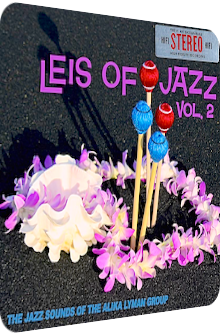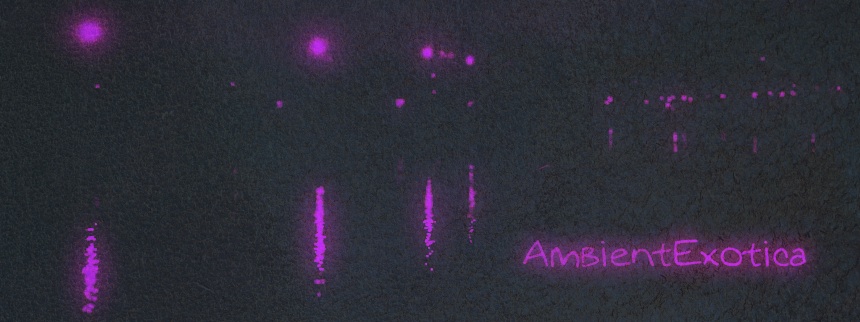
Alika Lyman Group
Leis Of Jazz, Volume 2
2014
Leis Of Jazz, Volume 2 is one of those albums that the connoisseur never saw coming. It may not outshine Robert Drasnin’s near-impossible accomplishment of dishing up a second installment to his classic Voodoo! (1958) a mere 48 (!) years later, but the following achievement is still certainly more than just a sidenote in the world of Exotica, Latin Jazz and its peripheries: enter the Alika Lyman Group, spearheaded by skilled guitarist, composer and grandnephew of… well…? Arthur Lyman (1930–2002) of course, one of Exotica’s greatest vibraphonists, birdcallers and talented arrangers whose records showcase a depth and pristine purity that still amazes audio engineers to this day once they encounter the mesmeric material.
The original Leis Of Jazz (1957), however, is the famous mixed bag when you ask truly dedicated followers. Its table of contents does share a few escapist sentiments, but is basically the work of a dedicated Jazz quartet. This is exactly Alika Lyman’s angle as well, but he knows to embellish and amend to the vivacity with the aid of field recordings, both unique and classic material and the prestidigitation of one Mark Riddle aka radio host/podcaster Digitiki aka Marty Lush aka loving father of two. The vibraphonist not only produced this album, he also got hold of his former band mate and percussionist Nelson Ortiz of Yavaz fame. Drummer Mark Gusek and bassist Justin Grinnell complete the quintet and deliver a carefully balanced rift to vintage valleys, ideal isles and whitewashed waters. Here is a meticulous look at a special album that encapsulates superstructures of leisure, with the liner notes written by Exotica expert Jeff Chenault. Enter Leis Of Jazz, Volume 2.
To be utterly honest – and almost cruelly so –, once I found out that the opener is a rendition of Duke Ellington’s and Irving Mills’ faux-Hapa Haole standard Swingtime In Honolulu, I had various chintzy interpretations in mind, and indeed, the well-known melody has become efflorescent rather than fluorescent over the decades. Then I remembered two things: first Lisa Ono’s gorgeous tropicana version as featured on her sun-dappled mango pericarp Bossa Hula Nova (2001), and second the mere fact that Ellington’s evergreen allows the perfect blending of Exotica craftsmanship in general with Alika Lyman’s Jazz roots in particular. Indeed, his group makes a diamond out of a dob. Delicately hollow bongo drums echo from behind, Justin Grinnell’s archetypical double bass billows evoke mirages of a steamy Jazz cellar as a counterpoint, all the while Mark Riddle’s vibraphone is in a stop-and-go dialog with Alika Lyman’s sunset-colored guitar chords. It is in fact these vibe-heavy segues that stray away from the otherwise perfectly carved out paths, unfurling that kind of planned improvisation that is so ubiquitous in modern takes on Exotica classics.
The band members then swing their way to the mighty Poinciana, originally envisioned by Buddy Bernier and Nat Simon. I am usually more fond of symphonic interpretations as found, for instance, on Les Baxter’s nocturnal-benthic Caribbean Moonlight (1956) or Percy Faith's self-explanatory Exotic Strings (1962), but the quintet sound has its advantage: it makes for a tropical verdure and hammock-friendly aureoles. Justin Grinnell’s bass twangs are crunchy, Nelson Ortiz’s mamba maracas sizzle their way to the cochleas, with the heterodyned vibraphone/guitar frequencies offering a wonderful high-plasticity simultaneity of glacial sultriness. The sustain and glissando phases of the stringed and the mallet instrument only augment the paradisiac cannelure.
There is more to Leis Of Jazz, Volume 2 than just a roster of vintage material, for the original Night Orchid takes a bow before Cal Tjader’s stupefying masterpiece Black Orchid but, as is the case with Mr. Ho’s alteration on Where Here Meets There (2013), morphs into something different. The shakers and drums are amplified and more varied, birdcalls or related field recordings provide the bokeh backdrop to Alika Lyman’s aqueous riffs and Riddle’s interstitial vibe blotches. Instead of instantly catchy overtones, Night Orchid exudes the vapor of captivating textures and skilled interplay. Like an orchid, the different patterns and surfaces are colorful enough a titration to allure the Exotica aficionado. Kauai Rose meanwhile turns out to be the floral foil; written by Alika Lyman, this midtempo ctenidium is gorgeously oneiric, depicting a languorous horticultural shangri-la complete with chirping birds and an increased amount of legato movements, making this the sparkler for fans of the, er, Ambient Exotica genre.
Five songs into the album, and the first Hapa Haole/Hawaiiana classic is rolled out: Charles E. King’s Kaimana Hila is less considered in today’s times, but transformed here with a cautiously reverberated lead guitar whose moist afterglow merges with vibraphone convulsions. The double bass feels again more ligneous and punchy, the percussion is based on a classic drum kit with scattered bongo vesicles. A swinging piece completely devoid of the saccharified ukulele craze of the late 50’s. Up next is a treat: Jack Owens’ Hukilau Song rolls along in a surprisingly fast-paced fashion as the band tries to keep the balance between the uplifting tone salvos and droning dreaminess of the veiled vibes, showcasing another time that this is a record that is partly Jazz, partly Exotica.
Le Kukui follows, another Alika Lyman original which, according to Jeff Chenault’s liner notes, is a modern representation of Arthur Lyman’s Billboard stomper Yellow Bird of the eponymous (or not so eponymous) album from 1960. One can see what the grandnephew has in mind as this is basically a reverie made up of a dialog between the ukulele and vibraphone. The sustain covers the black nothingness so that the friendly aura is always maintained throughout the song’s runtime. Arthur’s Line then is a faithful reproduction of a title that was written for Arthur Lyman back in dem days. Cocktail vibes, cavernous finishes, woodpecker bongos and Surf Rock vestiges are the notable careful ornaments to the embroidery. Up next is a delightful quartet transmutation of Howard Greenfield’s and Jack Keller’s Theme From Bewitched, and not only is this a singalong ditty, its magic is also interpolated by Mark Riddle’s bucolic vibe blebs and another dose of suntrap licks, the latter of which are the somewhat raucous contrapuntal scapegrace to the syringa ambiance.
While the follow-up Guiding Stars is an original from Alika Lyman’s feather and shows the physiognomy of a slowed-down bar complete with a mellow guitar and an unexpected piano undercurrent akin to Kenny Sasaki & The Tiki Boys’ Snow On The Beach (2001), Bobo is another original track and a wonderfully sanguine/rufescent Bossa Nova not unlike the aforementioned Yavaz’s glistening Betty’s Bossa off Sea Of Cortez (1997). Since this is no coincidence at all, let’s just say that all people involved in both albums have the Latinisms still running through their veins. And that’s not all, for inebriant adjuvants and concupiscence are the queens on the burlesque Hilo Hattie Blues which unites Riddle’s Honky Tonk tercets with Alika Lyman’s raucous-smoky guitar before the end is nigh on Pua Lilia, a song that is over 100 years old by now, ameliorating the thankfulness of living in the tropics via a rhythm ukulele and warped midday guitar chords. Even the vibes shuttle between grandeur and drowsiness, and so it is time for that much-needed nap amid the birds.
Leis Of Jazz, Volume 2 sees the continuation of a 50’s album by Arthur Lyman that keeps on remaining under the radar even as you read these lines. The reason is obvious and only lets this follow-up grow stronger: the original Leis Of Jazz is no Exotica album, at least not if the commentariat is asked. If one widens the viewpoint and agrees to consider Latin Jazz sparks or –gasp! – even a slew of smooth Funk albums of the 70’s as planetoids that gyre around the outmost peripheries of the epicenter that is called Exotica, chances are that Arthur Lyman’s Leis Of Jazz has that certain breezy spirit. Those who think of it as a non-exotic commitment will definitely be up for the vision of the Alika Lyman Group: not only is the jazzier sound nurtured and grafted onto the pillars, no, there is also plenty of truthful Exotica to be found, even though this genre means many things to even more people.
Birdcalls and field recordings are included, bongos and exotic percussion devices are on board alright, but the album is carried by Lyman’s guitar and Riddle’s vibes. This is a good thing, for it also implies a focus on melodies. And yet is there a suave focus attached to each and every song. Arthur Lyman and his men were always keen of integrating drum solos and the utmost widest array of textures and patterns. These are not featured here. Instead, Leis Of Jazz, Volume 2 is much more similar to the moony Hawaiian Sunset (1958) and, duh, the original Leis Of Jazz itself. It remains clear all the time that this is the benchmark, the connecting bond between Arthur & Alika, both of whom were or are trained Jazz musicians. It could well be that this second volume might encourage the devoted Exotica fan to check out the original once more in order to savour the similarities and hidden qualities. It would be worth it, a win/win situation for every party involved.
Further listening and reading:
- Leis Of Jazz, Volume 2 is available on CD and at iTunes, Amazon MP3 and cohorts.
- Mark Riddle interviews Alika Lyman in his Quiet Village Podcast 66.
Exotica Review 359: Alika Lyman Group – Leis Of Jazz, Volume 2 (2014). Originally published on Jul. 19, 2014 at AmbientExotica.com.
